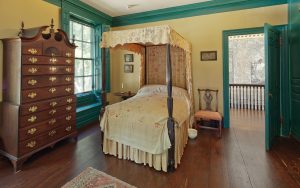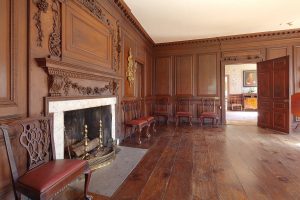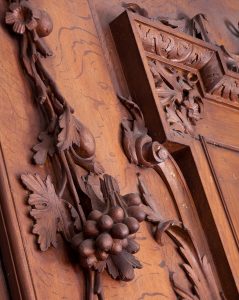The 1768 Lee Mansion is a magnificent Georgian home built by American craftsmen for Jeremiah Lee, the wealthiest merchant in Colonial Massachusetts. Preserved in a nearly original state, the house stands as a tribute to both Colonial America's strong ties to England and its independent commercial success.
Open June 1st through October 31st.
CLOSED FOR THE SEASON. SEE YOU IN 2025!
Click Here to Book Your Tickets.
Tuesday through Saturday, 10am-4pm. Tours leave on the hour. (last tour leaves at 3pm).
161 Washington Street, Marblehead, MA 01945
Admission: Adults $10; free for Museum members, NARM, MTA, for families with EBT, WIC, and ConnectorCare cards, active duty military and their families, and children under 14.
The Lee Mansion is not wheelchair accessible.
We are proud to participate in the Card to Culture program, a collaboration between Mass Cultural Council and the Department of Transitional Assistance, the Women, Infants & Children (WIC) Nutrition Program, and the Massachusetts Health Connector, by broadening accessibility to cultural programming.
Many of the Mansion’s original decorative elements have been preserved, including rare 18th century English hand-painted wallpapers – the only such wall treatments surviving in place. The house is furnished with an outstanding collection of early American furniture, including examples by Boston, Salem and Marblehead cabinet-makers. Decorative arts from the 18th and 19th centuries, including ceramics, silver, mirrors, clocks, and textiles, are displayed throughout the building.
NEW! Click here to take a 360 VR Tour of the first floor of the Lee Mansion!!
Hint: for best results, watch in 4k quality or on YouTube.
Funded, in part, by the Massachusetts Office of Travel and Tourism.
This video was made possible by a grant administered by the North of Boston Convention & Visitors Bureau.
Also, browse the beautiful Lee Mansion Gardens, maintained by the Marblehead Garden Club since 1936. Featuring period plantings and historically-inspired designs, the Garden is a relaxing place to walk, eat a picnic lunch, or just rest in the benches. A new self-guided tour of the Garden is a great way to explore the space. Partly wheelchair accessible.
Jeremiah Lee (1721-1775)

A ship owner and merchant, Col. Jeremiah Lee was one of the most affluent men of the English North American colonies. His vessels, laden with salted and dried fish, sailed to ports in the West Indies, delivering the poorer quality fish for plantation owners to feed to their enslaved individuals. His ships then traveled to various ports along Europe's Atlantic coast, selling fish and acquiring goods to bring home. His ships returned to Marblehead full of wine, fruit, textiles, flour, and other commodities to sell.
In 1766, at age 45, Col. Lee began building the Mansion. Only the best quality woodwork, hand-painted wallpaper and custom-made furnishings were used in this public statement of Lee’s wealth and importance in the community. Amazingly, most of the architectural elements remain intact.
Lee lived here with his wife, Martha, and their six children. Joseph, the eldest son, went to Harvard College in 1768 and got married in 1771. Mary, the eldest daughter, married wealthy Newburyport merchant Nathaniel Tracy in February 1775. Lee was a slaveowner, owning three enslaved individuals when he died in 1775. Whether or not some of all of the enslaved people lived in the Mansion or his adjacent building is unknown.
Jeremiah Lee was also an ardent patriot. He was active in town government and served as Colonel of Marblehead’s town militia for 25 years. Lee participated in the Massachusetts province’s new congress and was elected leader of a regional political body that dealt directly with the military governor appointed by King George II and III. Using his trading agents in Spain, Lee procured weapons and ammunition which he then smuggled into various locations in towns outside of Boston. His involvement in the preparations for armed conflict between England and the colonies in April 1775 turned deadly after a meeting with John Hancock, Samuel Adams and fellow Marbleheaders, Elbridge Gerry and Azor Orne. The three Marblehead men had settled down for the night at the tavern where they had held their meeting. Disturbed by the British Regulars marching toward Lexington, the men left the tavern and hid in a corn field. Jeremiah Lee became ill with fever from the exposure and died three weeks later in Newton at age 54, on May 10 1775.

Col. Lee died without leaving a will. The war, a business network based primarily on credit, and the complexities of a new form of government disrupted everything. It took 13 years for the estate to be settled. In 1788, Lee’s estate was declared bankrupt and the assets were liquidated.
After 1785, title to the Mansion was held by mortgage holders. Following the death of the Lee’s eldest son, Martha waived her widow’s rights and title passed to her son-in-law Nathaniel Tracy. Title then went to Tracy's creditors. In 1804, nearly thirty years after Lee’s death, the Mansion was bought by the newly-formed Marblehead Bank, which owned the Mansion until 1904, when it ceased operations. The bank made few changes to the building and the Marblehead Historical Society (now Marblehead Museum) purchased the Mansion in 1909.







